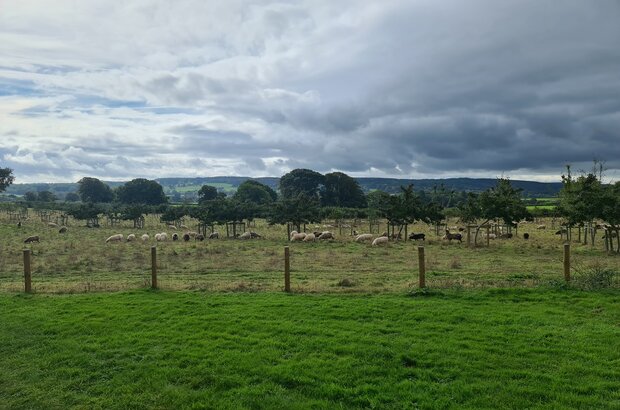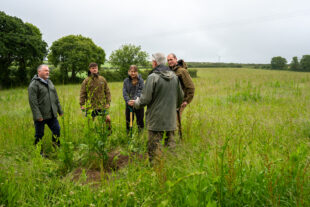
The Agricultural Transition Plan update includes the full range of new and updated Sustainable Farming Incentive (SFI) actions and the payment rates available in 2024.
In this post, we will focus on the new agroforestry actions. Agroforestry is tree planting that is deliberately combined with food production on the same land. It can:
- reduce soil erosion
- improve water and air quality
- provide shelter for livestock and crops
- reduce flood risk
- improve food, fuel or timber production potential
- increase biodiversity
- capture and store carbon
- improve climate change resilience.
Through these actions, we want farmers and land managers to consider planting more trees in suitable places and manage more of our woodlands.
In this post, we’ll also include improvements to the Countryside Stewardship (CS) offer for trees and woodlands.
New agroforestry actions
We’re introducing in-field agroforestry actions across various tree densities to encourage more trees in the farmed landscape.
The agroforestry actions are a vital part of our work to meet our ambitious net zero, biodiversity and environmental objectives.
To that end, the actions have been designed to appeal to the widest range of farmers and are applicable on the widest range of land types.
Everyone’s situation is different, so we want to provide as much choice as possible.
We are introducing new actions to create and maintain in-field agroforestry systems of which there are 2 main types:
- Silvoarable: trees are planted at wide spacings and intercropped with a cereal, horticultural or other crops (crops are grown in the space between the tree rows)
- Silvopastoral: trees are combined with forage (plants eaten by livestock) grassland and livestock production.
The arrangements and densities of trees is flexible to allow you to decide what is best for your circumstances.
For example, silvoarable tree planting arrangements traditionally use widely spaced rows of trees, but you could use this design equally in a silvopasture setting, especially when managing grass for grazing and silage cutting.
The lower tree density actions enable agroforestry to be carried out on land with low sensitivity to tree planting without requiring Environmental Impact Assessments for woodland (EIA) however, you may need to get a screening decision under the agricultural EIA regulations from Natural England. For example, those who want to do a basic level of tree planting with a small number of trees on the land they farm.
This makes agroforestry accessible to those that want to try this innovative approach and to tenant farmers too. Tenant farmers should check their tenancy agreement before including agroforestry actions in their SFI agreement.
The higher tree density actions provide for those who want to maximise the benefits from agroforestry planting, including those who are already confident implementing agroforestry practices. We will release more details on these offers and EIA requirements in due course.
These new agroforestry actions complement agroforestry offers already available in CS, providing land managers with more flexibility and more ways to integrate trees on their land, including hedgerow, wood pasture and parkland and traditional orchard.
We’re continuing to support woodland creation through the England Woodland Creation Offer (EWCO) which supports, among a wide range of other things, riparian planting.
The full list of agroforestry actions are:
|
Actions to maintain high or medium density in-field agroforestry |
|||
| Action | Duration | Annual payment |
Action’s aim |
| Maintain high density in-field agroforestry | 10 years | £849 per ha | An in-field agroforestry system is maintained, so there’s a combination of either trees and arable or horticultural crops, or trees and grassland for forage and livestock |
| Maintain medium density in-field agroforestry | 10 years | £595 per ha | An in-field agroforestry system is maintained, so there’s a combination of either trees and arable or horticultural crops, or trees and grassland for forage and livestock |
| Actions to maintain low density in-field agroforestry | |||
| Maintain low density in-field agroforestry on less sensitive land | 3 years | £385 per ha | An in-field agroforestry system is maintained, so there’s a combination of either trees and arable or horticultural crops, or trees and grassland for forage and livestock |
| Maintain low density in-field agroforestry on more sensitive land | 10 years | £385 per ha | An in-field agroforestry system is maintained, so there’s a combination of either trees and arable or horticultural crops, or trees and grassland for forage and livestock |
| Actions to maintain very low density in-field agroforestry | |||
| Maintain very low density in-field agroforestry on less sensitive land | 3 years | £248 per ha | An in-field agroforestry system is maintained, so there’s a combination of either trees and arable or horticultural crops, or trees and grassland for forage and livestock |
| Maintain very low density in-field agroforestry on more sensitive land | 10 years | £248 per ha | An in-field agroforestry system is maintained, so there’s a combination of either trees and arable or horticultural crops, or trees and grassland for forage and livestock |
Improvements in our offer for trees and woodland
As well as adding new actions to our environmental land management schemes, we made several improvements to our existing offer for trees and woodland within Countryside Stewardship.
We are improving the existing woodland management offer by:
- reducing the minimum threshold from 3ha to 0.5ha, so more farmers and land managers can access funding
- increasing payment rates to ensure funding better reflects the costs incurred by woodland managers
- making it simpler and more flexible including removing the deadline for when Woodland Management Plans must be submitted for the woodland improvement offer
- expanding the range of supplements to target priorities with 8 new actions available
- retaining existing capital items, for example to produce a plan for action within woodlands (Woodland Management Plan)
We are improving our offer on wood pasture by:
- making actions simpler and more flexible
- combining actions for lowland and upland wood pasture, having aligned the payment rates earlier this year
We are improving our species management support to protect trees, woodland habitats and threatened woodland species by:
- continuing to control the population of invasive non-native grey squirrels where they’re causing significant damage to woodlands and trees
- managing the impact of deer on crops and in woodland through the introduction of new and amended actions and expanded eligibility
- enhancing rhododendron control and management
- expanding the threatened species supplement to cover woodland species
- introducing measures to control the population of invasive edible dormice that cause damage to trees and orchards by stripping bark, compete with hole-nesting birds for nest sites, and prey on eggs and nesting birds.
We will improve our tree health support offer by expanding the tree health support in Countryside Stewardship using learning from the Tree Health Pilot. The current Tree Health Pilot grants will continue until the full, revised tree health scheme launches, ensuring there is no gap in support for land managers and tree owners with tree health issues.
Finally, we are improving public access and engagement with woodlands to benefit public health and wellbeing by adding new actions for permissive access, and expanding the current educational access option so that more people can visit woodlands to learn about woodland management and forestry.
Learn more and apply for SFI
You can apply for an SFI agreement now and choose from the 23 actions currently available.
By waiting for the 2024 actions, you could be losing out on funding. If you apply now, you'll be able to add actions to your agreement annually — or have multiple agreements — if you'd like to carry out further actions. You can view the full list of actions available in the combined SFI and CS offer on GOV.UK.
Webinar
On 26 January at 10am, we’re hosting a webinar about the farming offer in England with the Farming Advice Service. Register to attend.
Funding for farmers, growers and land managers
The guidance for every scheme and grant on offer can be found on the Funding for farmers, growers and land managers page on GOV.UK.




27 comments
Comment by James Moon posted on
When can the new Argo forestry agreement be added to an existing SFI if they have just started or are about to sign up this spring.
Comment by The Team posted on
Hi James,
You can apply for an SFI agreement now and choose from the 23 actions on offer. By waiting for the new actions coming in summer, you could be losing out on funding. If you apply now, you'll be able to add actions to your agreement annually - or have multiple agreements when the further actions are available - if you'd like to carry out further actions.
Best wishes,
The Team
Comment by Hugh Roper posted on
Will it be possible to stack agroforestry options with other SFI or CS options such as herbal leys, very low input grassland or flower rich areas and will the agroforestry payments be made on the actual area of trees planted in a field or provided they meet a minimum density the payment is made over the full field area? It would be useful to know on the stacking query as I am delaying some applications now in case this is not possible.
Comment by The Team posted on
Apologies, Hugh. In our initial response to your comment, we didn't answer your question as clearly as we could have.
You will be able to combine agroforestry actions with other SFI or CS actions. We will release more details on what options are compatible with agroforestry in due course. We will also be releasing further information on the specific requirements for agroforestry payments, including density requirements.
We hope this helps.
Best wishes,
The Team
Comment by Frank Broughton posted on
Will the agroforestry options be available through SFI or only under Countryside Stewardship?
Comment by The Team posted on
Hi Frank,
Thanks for your question. The agroforestry options will be available through the combined SFI and CS Mid Tier offer later this year.
For more information on the combined offer, visit this page on GOV.UK: https://www.gov.uk/government/publications/agricultural-transition-plan-2021-to-2024/technical-annex-the-combined-environmental-land-management-offer
Best wishes,
The Team
Comment by Mark Slaughter posted on
Are there any details available regarding what constitutes as being 'high, medium or low' density in-field trees, and how those 3 categories translate in terms of canopy cover?
Thanks
Comment by The Team posted on
Hi Mark,
We'll publish more details on this soon - it will be based on the number of stems per hectare.
Best wishes,
The Team
Comment by Peter Joyce posted on
Have you published the definitions of High, Medium, Low and Very Low Density in terms of stems per hectare yet?
Comment by The Team posted on
Hi Peter,
Thanks for getting in touch. We have published the low density definitions for SFI actions AGF1 and AGF2 here: https://www.gov.uk/find-funding-for-land-or-farms?areas_of_interest%5B%5D=agroforestry
We’ve also introduced new capital items to support the SFI agroforestry actions to help protect trees while they are established and grant funding is available for items including tree guards, the list of capital grants and the guidance for applicants can be found here: https://www.gov.uk/government/publications/capital-grants-2024
Colleagues at the Forestry Commission will publish an agroforestry post on their blog soon which you can subscribe to here: https://forestrycommission.blog.gov.uk/subscribe/
Please keep an eye on the blog for updates on high and medium densities.
Hope that helps,
The Team
Comment by J Janman posted on
Where’s the link to this recorded webinar?
Comment by The Team posted on
Hi,
The link to the recording is in this blog post: https://defrafarming.blog.gov.uk/2024/01/09/webinar-the-farming-offer-in-2024/
Best wishes,
The Team
Comment by Andrew Sithole posted on
Hi Team,
Perhaps some how unrelated to this post, but would you have any information on how timber sold from an agroforestry system is treated regarding income tax on sales versus that which comes from a commercial woodland?
Many thanks,
Andy
Comment by Sarah Stewart posted on
Hi Andrew,
This page by the Forestry Commission and HM Treasury might help: https://www.gov.uk/guidance/woodland-owners-tax-guidance#agroforestry
Best wishes,
Sarah
Comment by Andrew Sithole posted on
Thank you very much Sarah.
Regards
Andrew
Comment by Alison Allen posted on
Have the requirements for densities of tree planting been published yet? Will these be available as SFI or Countryside Stewardship options?
Comment by The Team posted on
Hi Alison,
Current actions available are SFI actions, AGF1 and AGF2 for low stocking densities. More info can be found here: https://www.gov.uk/find-funding-for-land-or-farms?areas_of_interest%5B%5D=agroforestry
We’ve also introduced new capital items to support the SFI agroforestry actions to help protect trees while they are established and grant funding is available for items including tree guards, the list of capital grants and the guidance for applicants can be found here: https://www.gov.uk/government/publications/capital-grants-2024
Colleagues at the Forestry Commission will publish an agroforestry post on their blog soon which you can subscribe to here: https://forestrycommission.blog.gov.uk/subscribe/
Hope that helps,
The Team
Comment by Sam posted on
Hi,
I am interested to know the outlined density requirements for the agroforestry in medium and high as low and ultra-low have been announced, and when will we be able to apply for these high and medium options? It seems a little odd that they weren’t all released together.
I don’t want to go ahead and plant trees and be just under a threshold.
Comment by beckybriggs posted on
Hi Sam,
Thanks for getting in touch. The exact tree densities have not yet been released and the higher tier grants haven't launched but we will provide updates on the blog, if you subscribe you'll be notified straight away: https://defrafarming.blog.gov.uk/subscribe/
In the meantime, you could apply for a PA4 Agroforestry Plan to work up your ideas and plans for agroforestry on your land now. PA4 is designed to allow you to consider agroforestry within the wider context of your land and how it fits in with your local environment and business, more guidance can be found here: https://www.gov.uk/countryside-stewardship-grants/pa4-agroforestry-plan#what-you-must-do-to-use-this-item
Please do contact grnationalteam@forestrycommission.gov.uk for more support, providing an address and postcode to enable them to direct agroforestry enquiries to your local AFWO.
Hope that helps,
The Team
Comment by Paul posted on
Hello can existing orchards have trees removed and be used in agroforestry applications or does it need to be new plantings
Thank you
Comment by beckybriggs posted on
Hi Paul,
Thanks for getting in touch. This depends on the type of orchard. A bush orchard with semi vigorous rootstocks planted closely maybe restructured into an agroforestry system, but a PA4 agroforestry plan would be needed to assess how this is possible as it may not always be desirable. You can find out about eligibility and requirements for the PA4 agroforestry plan here: https://www.gov.uk/countryside-stewardship-grants/pa4-agroforestry-plan#what-you-must-do-to-use-this-item
If it is an open planted traditional orchard on vigorous rootstock, it is not eligible for agroforestry.
Please contact grnationalteam@forestrycommission.gov.uk for more support, providing an address and postcode to enable them to direct your agroforestry enquiry to your local AFWO.
Hope that helps,
The Team
Comment by Rob posted on
"The lower tree density actions enable agroforestry to be carried out on land with low sensitivity to tree planting without requiring Environmental Impact Assessments for woodland (EIA) or an agricultural EIA. For example, land managers who want to do a basic level of tree planting with a small number of trees on the land they farm. "
If you're in a low sensitivity area and planting at the very low or low stocking rates, can you assume you don't need an agricultural EIA? Is their a table or guide that makes it clear when an agroforestry project does require an agricultural EIA or forestry EIA?
Comment by The Team posted on
Hi Rob,
Thanks for getting in touch. There is no table or guide. SFI levels of tree stocking arranged as per the patterns identified in SFI, will not require a Forestry EIA. Low stocking densities are less likely to require an Agriculture EIA but it would be prudent to check this with Natural England as there may still be a requirement. An agricultural EIA is required in semi natural areas and a screening decision should be sought where applicable, see full here: https://www.gov.uk/government/publications/changing-uncultivated-semi-natural-and-rural-land-when-you-need-permission
Please contact grnationalteam@forestrycommission.gov.uk for more support, providing an address and postcode to enable them to direct agroforestry enquiries to your local AFWO.
Hope that helps,
The Team
Comment by Neil Ash posted on
Hi team,
Is there a criteria or specification to help applicants determine whether "in-field" trees, planted in a sivopastoral context, count as agroforestry OR alternatively woodpasture e.g. under the existing WD12 option?
Thanks, Neil
Comment by The Team posted on
Hi Neil,
Thanks for getting in touch. Agroforestry in existing woodland or wood pasture is not eligible. WD12 is not an option that agroforestry can be applied to, you can read the requirements of this action here: https://www.gov.uk/countryside-stewardship-grants/wd12-creation-of-upland-wood-pasture#requirements
You will need to check your land type to see if agroforestry is a compatible action. If it is, here is some guidance about in field agroforestry and planting arrangements:https://www.gov.uk/guidance/a-guide-to-agroforestry#in-field-agroforestry
Please contact grnationalteam@forestrycommission.gov.uk for support, providing an address and postcode to enable them to direct agroforestry enquiries to your local AFWO.
Hope that helps,
The Team
Comment by Richard Walls posted on
When was the decision made to ONLY allow agroforestry on 'less sensitive ' land, as per the FC map?
I note that earlier in 2024 AF was to be allowed on 'more sensitive ' land also.
The disqualification of Agroforestry on more sensitive land removes a massive part of the countryside where tree planting/ AF would be beneficial.
I had FC and NE visit my land and the officers both approved potential planting on most of the area.
This seems a perverse decision to remove more sensitive land ( desktop classification) from SFI AF schemes.
In an email DEFRA/RP confirmed that NO Agroforestry SFI would be allowed on any land that is NOT 'less sensitive ' as per the FC map. Is this correct? Note my reference to FC.NE approval for tree planting.
Kind regards
Comment by The Team posted on
Hi Richard,
Thanks for getting in touch. SFI agroforestry is applicant led, with no advice, guidance, or oversight from agencies. When an applicant has a signed agreement from the RPA, they can proceed and plant/manage their trees. To enable this approach, pre assessment has been carried out using GIS mapping, identifying land with the lowest sensitivity to tree planting, resulting in the SFI Agroforestry layer.
Outside the SFI agroforestry layer, land may have sensitivities that need careful consideration. Higher Tier which opens in summer 2025, provides payments for agroforestry actions on more sensitive land: https://www.gov.uk/government/publications/countryside-stewardship-higher-tier-get-ready-to-apply/countryside-stewardship-higher-tier-actions#agroforestry
Hope this helps,
The Team